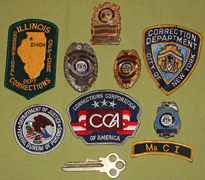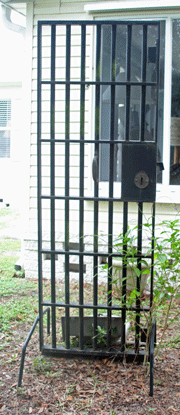|
Collecting Prison Antiques
By Rebecca Fritsche, Ph.D.
Posted March 2012
An interesting aspect of antiquing is the collecting of prison artifacts. Many prison antique collectors get into this hobby because their profession was in the corrections area, and they are drawn to the history of their field. Other prison collectors may have inherited a collection and become interested in that way. Still others may have been the residents of prisons or jails and had their lives impacted such that they became interested in collecting prison antiques. Whatever the motivation to begin collecting, they share one thing: The Love of the Hunt.
Prison collectibles can include a great many items from post cards featuring prisons to prison cell doors or perhaps even an abandoned prison! Refer to the picture of the cell door (aka “trellis”) in my backyard. Prison collectibles can generally be divided into three categories: prisoner-made artifacts; antique and vintage prison souvenirs; and prison relics—items actually used in prison operations. Since visits to prisons were often social events of the past, especially when an execution was scheduled, prison souvenirs and prisoner –made artifacts were readily distributed for fundraising. Items such as chinaware and even spoons with pictures of prisons were sold to tourists. Selling postcards of prisons was also a common practice.
Since prisoner-made artifacts and souvenirs were readily distributed, they are easier to find and more reasonable to obtain. The most challenging collectibles of the three categories is the prison relics themselves. These belonged to the governmental unit that operated the prison and were never for sale to the public. Because they are the most difficult to find and acquire, they generally bring the highest prices. Some of these collectibles include cell door keys, cell doors, guard/officer badges, inmate records, policy & procedure manuals, handcuffs, shackles, come alongs, paperweights, billy clubs, brass guard uniform buttons, inmate etiquette manuals, prison flags, tokens used instead of money, etc. Be careful if you are new to this area of collecting; there are reproductions being sold as antiques.
Prisoner-made artifacts and antique souvenirs can be found in antique shops, malls and on eBay. Specialty shows such as postcard/paper shows are another avenue to hunt for antique prison souvenirs and sometimes prison artifacts, such as prison inmate records. The desirability of these items is becoming increasingly well known and the prices are going up. Prisoner-made artifacts are often difficult to distinguish without knowing the history of the item in question. For example, a piece of art created by an inmate may be signed without any indication of his/her connection with a prison. If an item is being sold as prisoner-made, you want to verify the authenticity of the item prior to purchase.
As with the other two categories, antique prison relics can occasionally be found in an antique store or mall, but you’ll have to pay the price to get them. You may have more luck in an area near a prison or near the prison in which you are specifically interested. Don’t be afraid to leave your name and contact information with shop owners; you just never know. I’ve had one dealer that has been sending me prison postcards for over a decade now. Also, estate auctions are very good. If the ad mentions any affiliation between the owner of the estate and the prison system, chances are that some relics were kept for sentimental purposes. Prison employees often keep mementos from their employment that can be purchased at auction.
As is true of most collecting, the greater joy is not in possessing the items but in the process of the hunt. That’s the thrill that keeps us going.
See you behind bars!
-------------------
Dr. Fritsche served in the correctional system in Ohio for 20 years, and she began her collection of prison antiques at that time. Her collection includes hundreds of postcards of U.S. prisons, prison artifacts from various states and countries, and numerous volumes of prison-based books. Contact her at fribe1@yahoo.com
|

Badges of fabric or metal identifying the rank of officer and type/location of prisons.

This cell door came out of the historical Ohio Penitentiary in Columbus, Ohio.
|